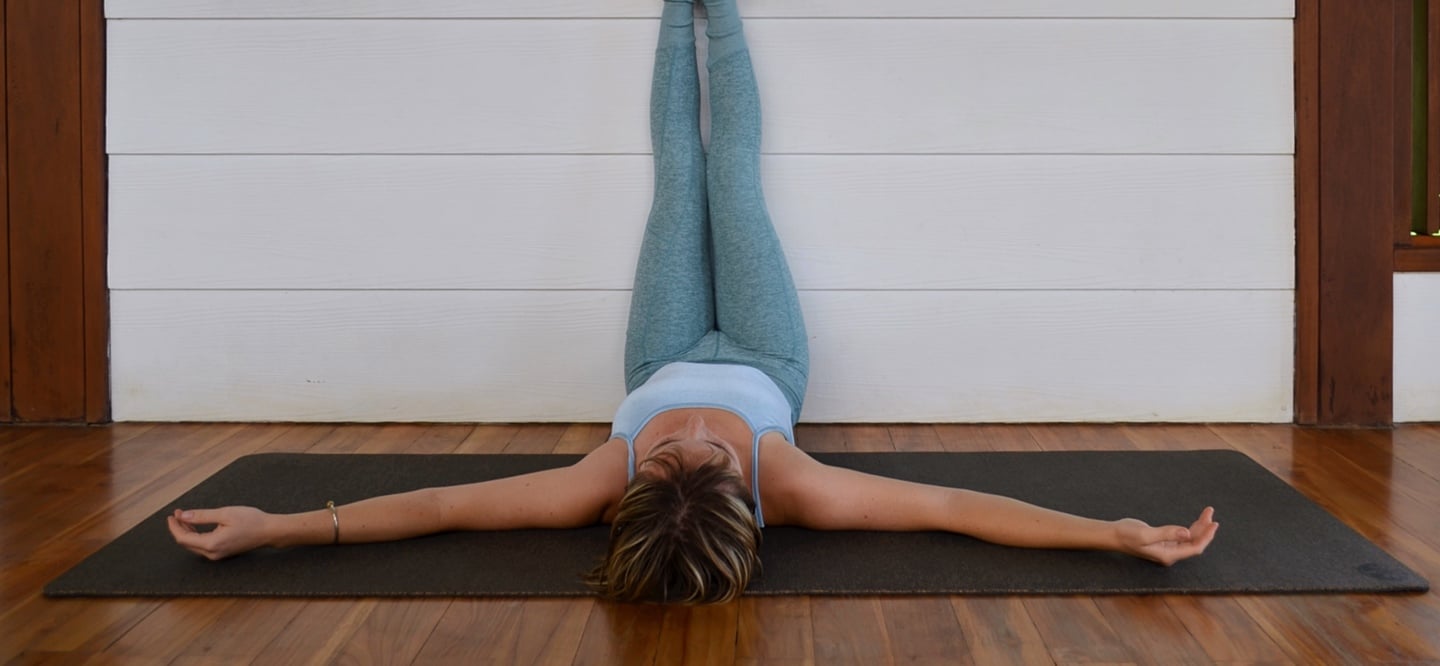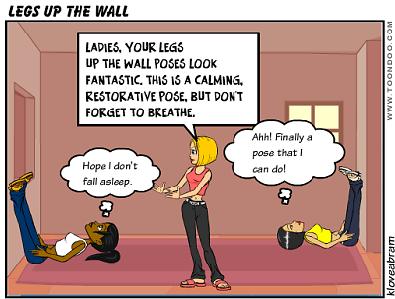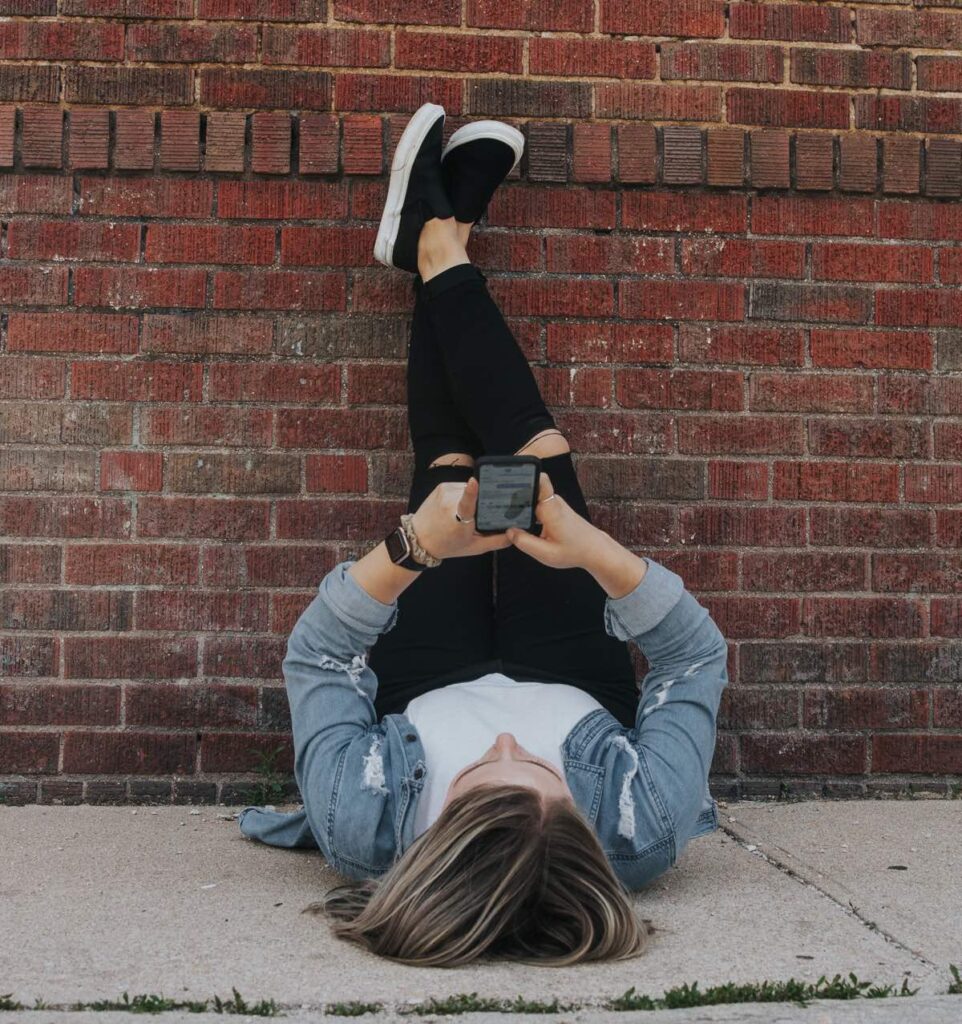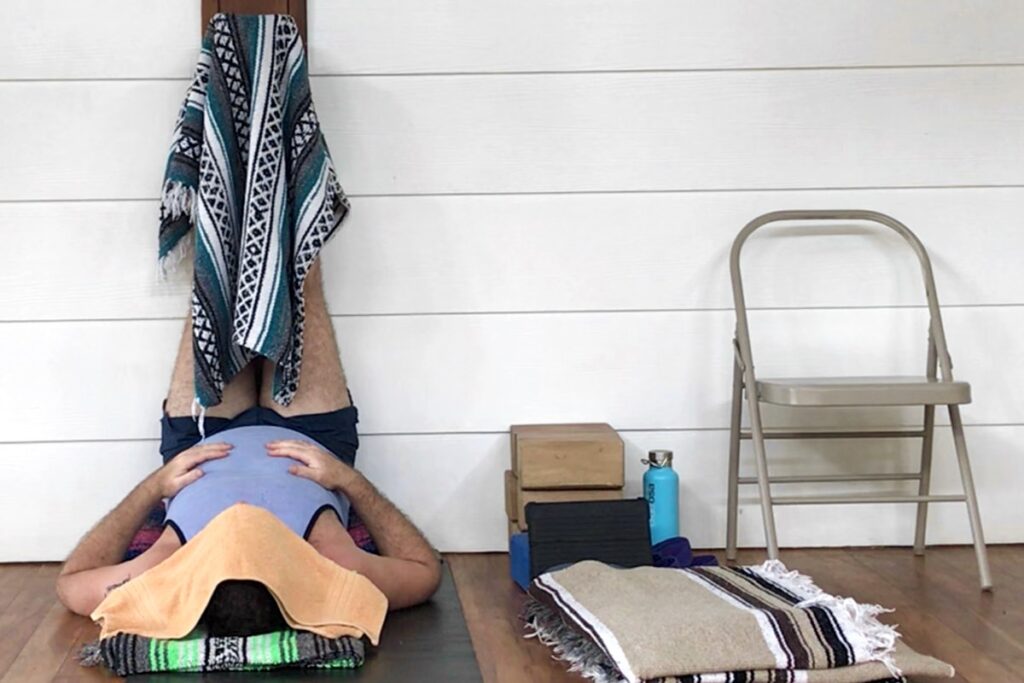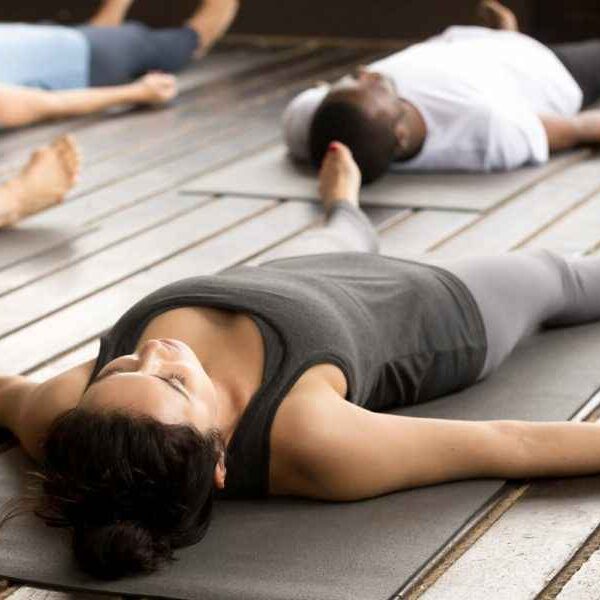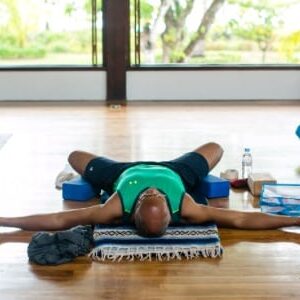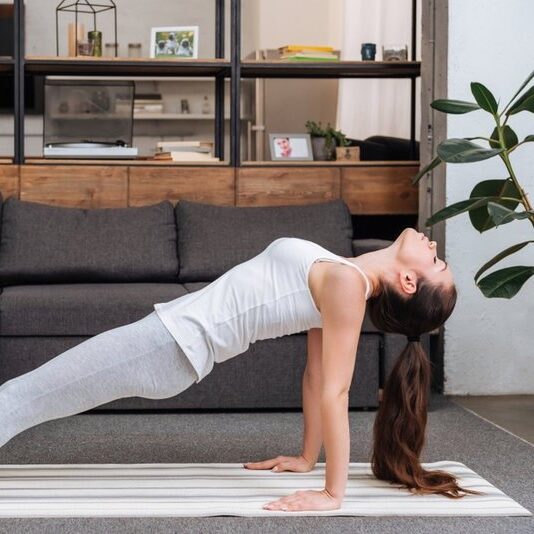At first glance, Viparita Karani (Legs Up The Wall) might not look like much. However, this restorative yoga posture offers profound benefits to the mind and body — plus, it’s a beginner yoga pose that’s accessible to all levels.
Here we are going to share with you ten reasons that you should practice Legs Up The Wall no matter where you are in your yoga journey . . . they just might shock you.
Ready to swap pain, discomfort, and stress for strength, mobility, and relief? Discover my simple hack to living a pain-free life.
What is Legs Up The Wall Pose?
Before we dive in, it helps to take a quick look at the Sanskrit name for Legs Up The Wall, Viparita Karani:
Viparita means reversed or introverted.
Karani means doing, making, or the action of practicing.
So, Viparita Karani refers to any type of inversion or yoga pose where you’re upside down. For this article, though, we’re going to refer specifically to Legs Up The Wall Pose.
This restorative yoga posture is precisely as it sounds: You lie on the ground with your legs fully supported against a wall (or other structure.)
There are numerous physical and mental benefits to practicing inversions, but not everyone is ready to flip into a headstand — and that’s okay! Legs Up The Wall pose provides an accessible introduction to the benefits of inversions and is safe for most individuals.
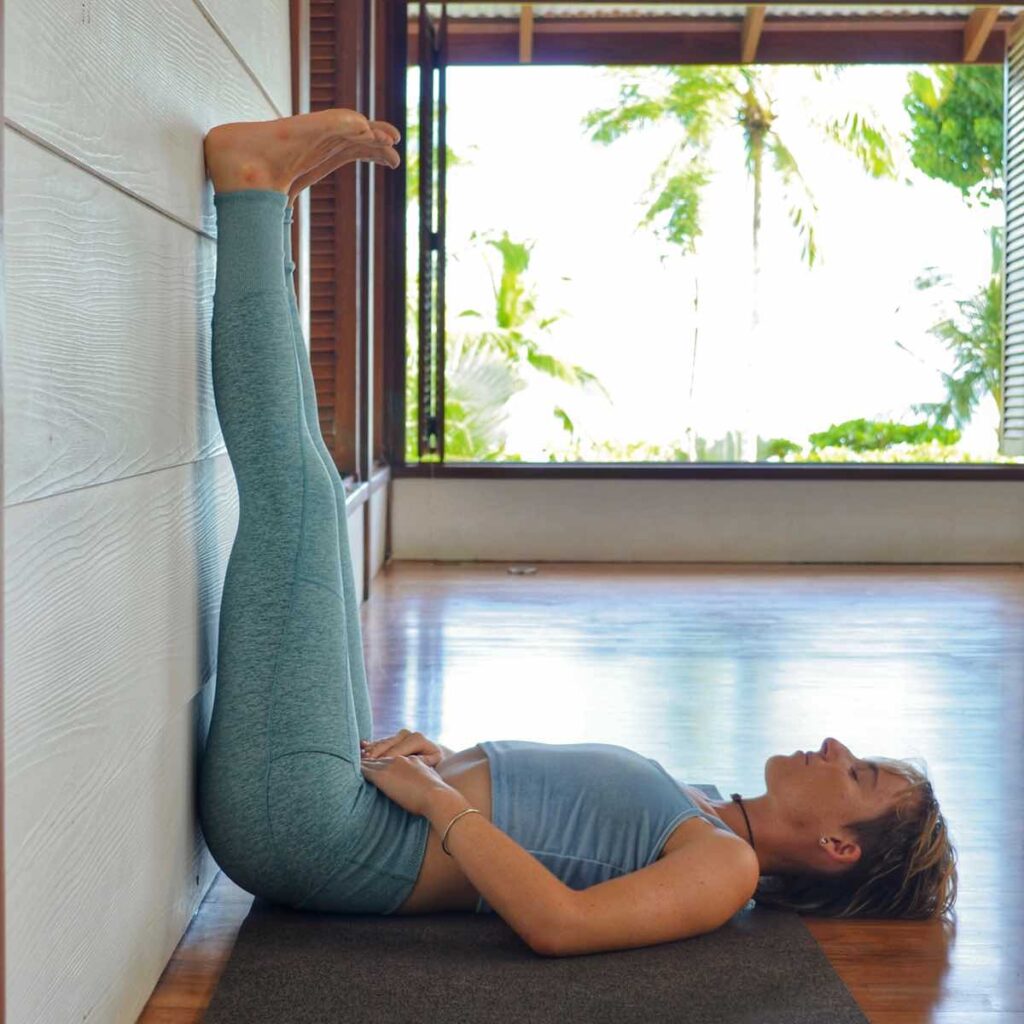
10 shocking Viparita Karani benefits
At a glance, here’s why Viparita Karani is so beneficial:
When your legs are higher than your heart, gravity can work to your advantage to improve the circulation of blood and lymphatic fluid. This creates a pleasant rebalancing that promotes several benefits to the body — let’s take a closer look at each:
1. Relieves tired, cramped, and swollen feet and legs
Our feet do a lot for us. Whether you’re an avid runner or you simply spend a lot of time standing, your feet deserve a little (or a lot) more love.
When you practice Legs Up The Wall, you allow lymph and other fluids to flow out of the feet and legs. This is an easy method to relieve tired feet, improve circulation, and reduce swelling.
2. Calms the nervous system
The beauty of Legs Up The Wall pose is that your legs and torso are fully supported. So being able to take a few deep breaths and relax into the pose completely is easy.
At first, you might find it challenging to spend more than a few moments doing nothing at all. That’s normal! However, we must recalibrate our nervous system to cope with stress and fatigue and to avoid burnout and illness. Restorative yoga postures are a powerful way to do exactly that.
So, throw your legs up the wall to calm that ‘fight or flight’ state — and revel in the splendor of just being.
3. Promotes sleep
Since Legs Up The Wall Pose is such a calming and relaxing posture, it makes sense that this pose would promote deep sleep, too.
Does your mind go into overdrive every evening before lights out? Do you need a simple way to shut off the body and prepare for sleep? Try Viparita Karani. You can even practice the post from the comfort of your bed; just throw your legs up your headboard!
Still not convinced? Check out this Harvard study on insomnia that found those who practice yoga sleep better and longer.
To learn more yogic sleep tips read How to Sleep Better with Yoga Nidra.
4. Boosts energy
Wait a second . . .
How can Legs Up The Wall Pose prepare you for sleep and boost energy?
Remember that Viparita Karani is still an inversion posture, promoting blood flow and relieving tension and fatigue. While Legs Up The Wall Pose isn’t akin to a shot of espresso, it is a revitalizing yoga posture that can improve energy and mental stamina.
Plus, when you sleep more and stress less, you have more energy for the things that matter.
5. Alleviates mild headaches
Legs Up The Wall Pose is an excellent opportunity to relax your head, neck, and shoulders fully. As you melt into the ground beneath you, you’re promoting the flow of blood and oxygen to the brain. Focus on the breath, and you might just find headaches and mild tension start to dissolve.
6. Relieves back pain
Do you suffer from back pain? Here’s a little-known secret:
Yoga might be making your back pain worse.
Before you do anything, read our complete guide to back pain relief. Then, give Viparita Karani a try. As you release your spine and neck onto the ground beneath you, you’ll release pressure and tightness in the lumbar region. Plus, you’ll activate the glutes and hamstrings, which can ease back pain, too.
Note: If you suffer from severe back pain or have recently had surgery, first see the contraindications below.
7. Lengthens the glutes and hamstrings
The purpose of Legs Up The Wall Pose is not to stretch. Not stretching may contradict everything you’ve ever learned in yoga or even from playing sports, but it’s true, we all need to stop the flexibility madness if we are ever going to prevent injury and promote healthy, mobile bodies.
That said, Viparita Karani is an excellent way to lengthen and activate the glutes and hamstrings, improving muscle function for a stable, pain-free life.
The key is to move your sacrum towards or away from the wall, depending on your mobility. Resist the urge to “stretch out” your hamstrings; instead, find a passive position that’s comfortable for at least a few minutes.
If tight hamstrings is an issue for you, read Tight Hamstrings? The #1 Thing You Should Do Today (It’s Not What You Think).
8. Improves digestion
Hold Legs Up The Wall for a few slow, steady breaths and let your digestive system get to work.
Digestion is interrupted when your body is stressed. So, just relaxing the body in Viparita Karani improves your digestive functioning! But there’s more . . .
With your legs up the wall, you reduce compression in the abdomen while improving blood flow to the digestive organs — both of which will enhance assimilation, digestion, and elimination.
9. Relieves menstrual pain
If you experience menstrual and premenstrual cramps, Viparita Karani can help to relax the pelvic floor and reduce symptoms. Place a cushion under the pelvis for additional support.
Note: Different schools of yoga have contrasting thoughts on whether it’s wise to practice inversions during your menstrual cycle. When in doubt, ask your teacher.
10. Improves sciatic pain
If you experience sciatica, then you already know just how painful it can be!
Legs Up The Wall Pose can lengthen many tight, compressed, or overused muscles that can lead to sciatica. Plus, becasue it’s the ultimate restorative yoga posture, you can stay in it as long as you need to relax and reset fully!
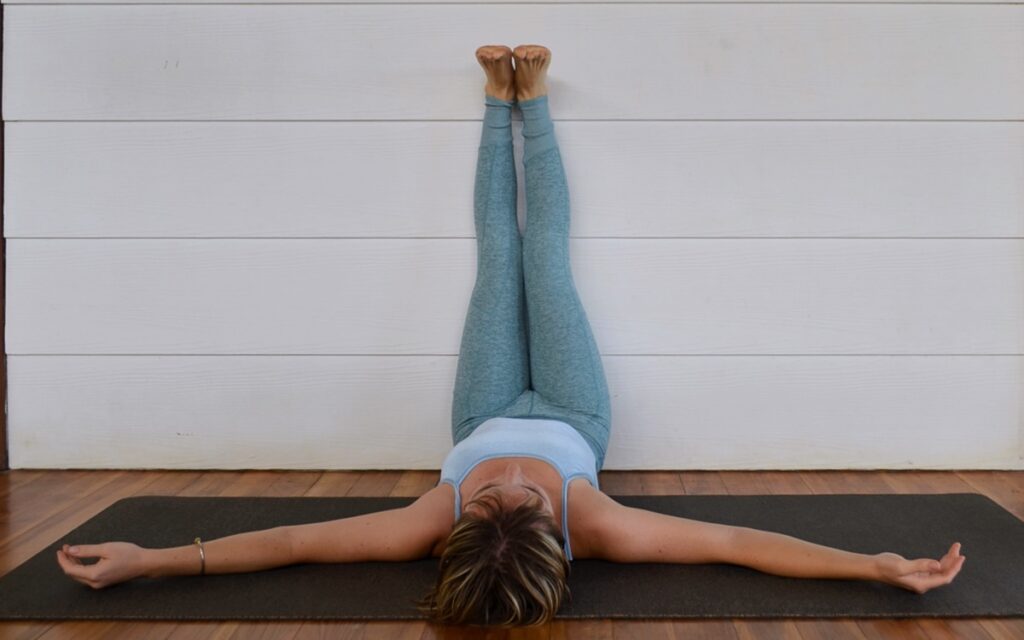
How to do Legs Up The Wall Pose
Now that we’ve explored the benefits of Viparita Karani, it’s time to give this rewarding yoga posture a try! Here’s how to do Legs Up The Wall Pose safely anytime you want to reap the rewards of this restorative posture:
Step 1: Take your mat to the edge of a wall. If your hamstrings are stiff, move your mat farther from the wall; if you’re more open, take your mat closer to the wall. Feel free to experiment until you get the perfect placement.
Step 2: Lie down on your side with your glutes at the lower edge of your mat. Swing your legs up against the wall. Relax onto your back, fully releasing your head, shoulders, and back onto the mat beneath you.
Step 3: Relax your hands on your lower stomach or release them by your sides. If it’s comfortable, you can straighten your legs against the wall. Just remember that we’re not trying to “stretch out” the hamstrings — a bend in the legs is perfectly fine! Release the heads of the thigh bones deeply into your torso, toward the back of the pelvis. Soften your eyes.
Step 4: Stay in this pose for anywhere from 5 to 15 minutes. When you’re ready to come out of the posture, lower your pelvis to the floor. Turn on your side. I recommend staying here for a few breaths before you come up to sit.
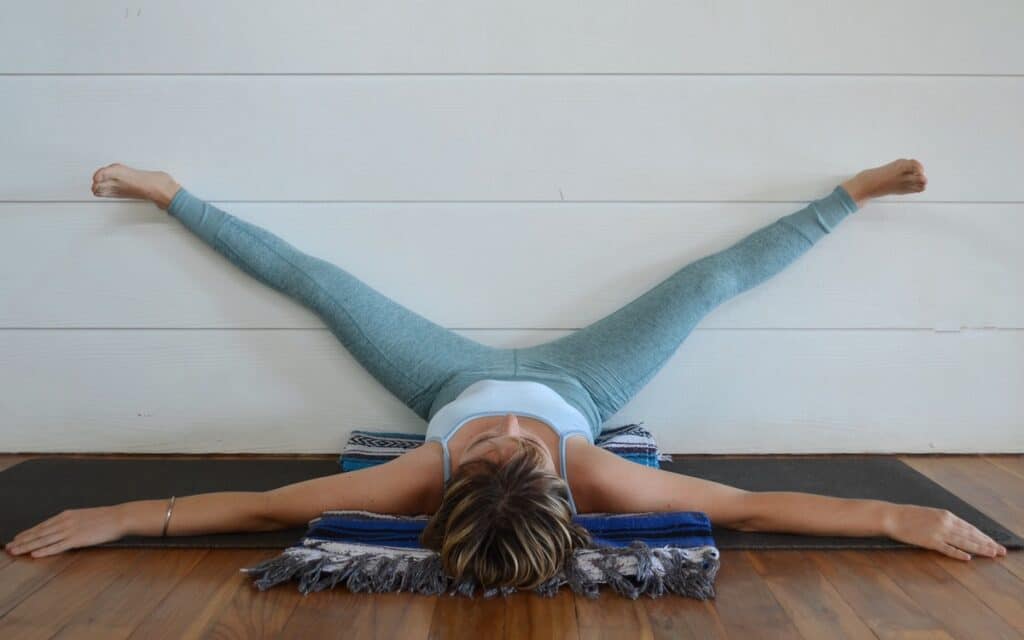
Modifications and variations for Legs Up The Wall Pose
- For additional relaxation and to promote a natural lumbar curve, place a bolster or blanket beneath the hips before lifting the legs against the wall.
- Using a firm yoga block beneath the sacrum is an excellent way to support the SI joints.
- Place a folded blanket beneath your upper back and shoulders for additional support and comfort.
- Have a sandbag handy? Bend your knees and flex your feet. Now, place the sandbag across your soles and re-straighten the knees. The weight from the sandbag helps to release tension in the lower back while providing a calming, grounding effect.
- Use a yoga strap around your thighs to support the legs and release through the groin.
- Try sliding your legs apart into a wide “V” to stretch your inner thighs and groins. If needed, use a strap to support your legs.
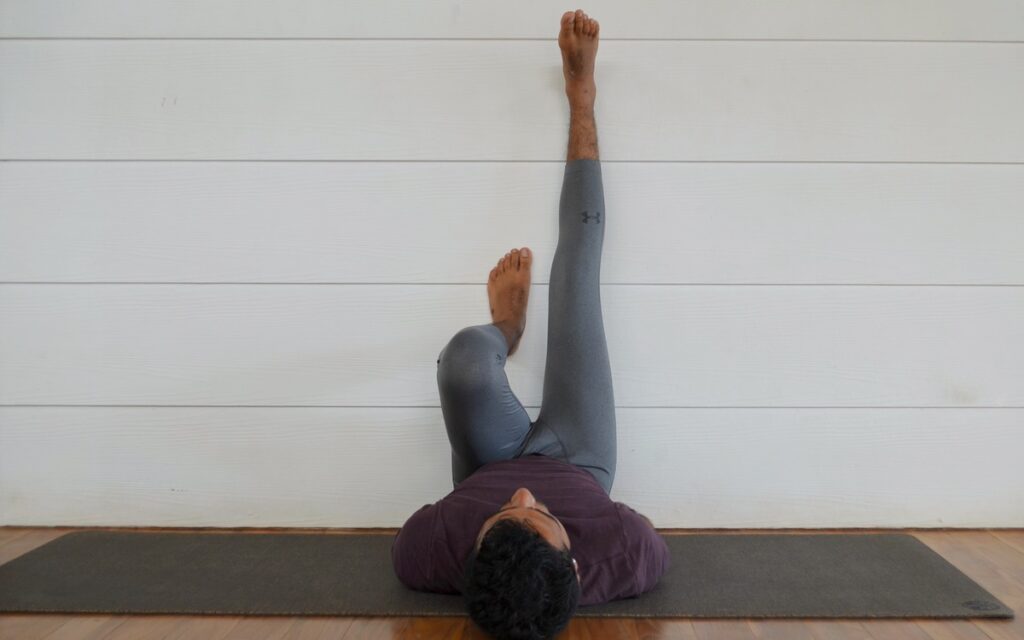
What if my hamstrings are too tight or I feel tingling in my feet?
Start by adjusting the distance between your hips and the wall. As you move further from the wall, you’ll decrease the flexion at your hips — which means reducing the strain and stretch to your hamstrings.
If it’s still uncomfortable to straighten your legs, try bending your knees and placing your feet firmly against the wall.
If the wall is still too much, you can rest your legs against a chair. Try with straight legs, or bend them and relax the claves on the seat as needed.
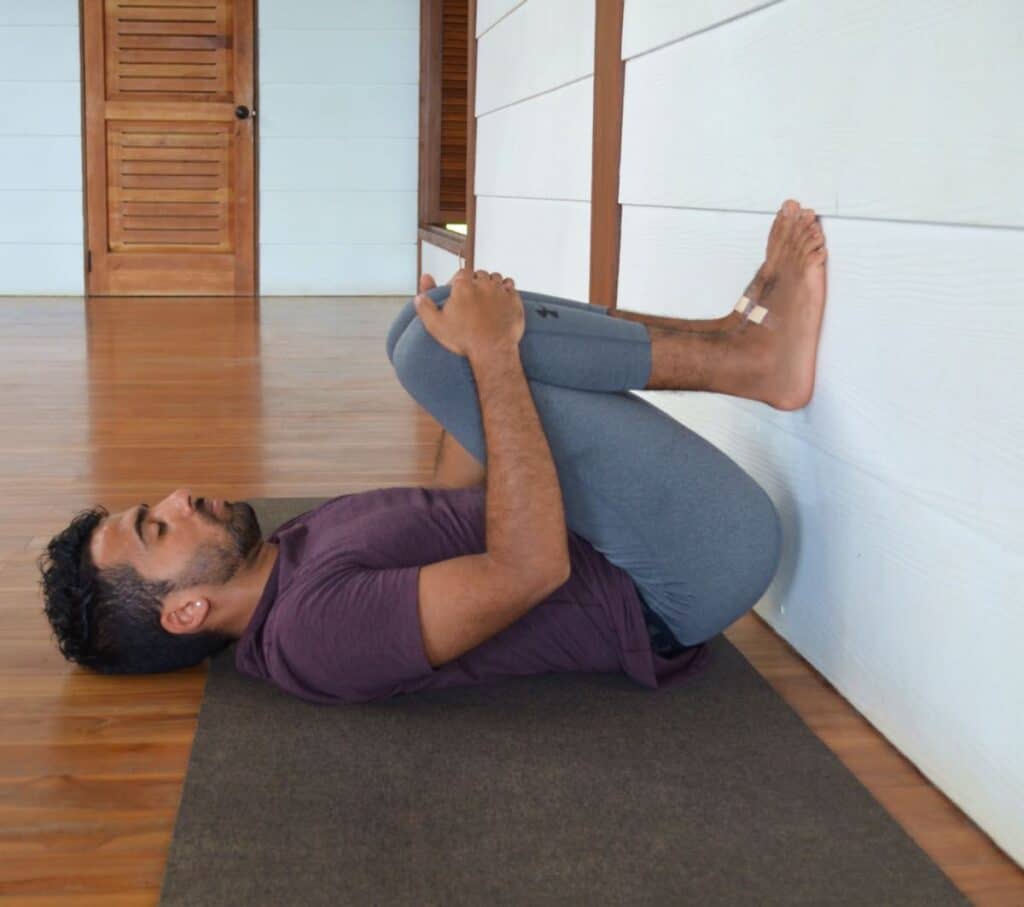
What if I can’t get up and down off the ground?
You know your limits. Practicing getting up and down off the ground is an excellent way to promote mobility — and Viparita Karani is a great excuse to practice this movement. You can always keep a chair nearby for support, too.
However, if the floor isn’t an option, try Legs Up The Wall on your bed. Simply swing your legs up your headboard or the wall behind your bed and reap all the Viparita Karani benefits.
Contraindications to Legs Up The Wall Pose
- Avoid Viparita Karani if you have serious eye problems, such as glaucoma.
- If you suffer from severe neck or back problems, practice this pose with a teacher.
- Feet starting to tingle? Bend your knees and slide the outer edges of your feet down the wall, so you bring your heels close to your pelvis.
How to prepare for Legs Up The Wall Pose
Viparita Karani is usually considered a restorative pose, sequenced near the end of practice. However, Viparita Karani can certainly be practiced on its own! Excellent preparation poses include:
- Setu Bandha Sarvangasana
- Supta Baddha Konasana
- Uttanasana
- Virasana
How to practice Legs Up The Wall Pose with a partner
A partner can help you support the thigh bones so you lengthen through the hamstrings. Ask your partner to stand at your head. Then, ask her to lean forward and spread her hands around your front thighs, just where they join the pelvis.
Inhale to push the thighs closer to the wall. On the exhale, have your partner support your thighs against the wall. Repeat this yoga pose for two people for several breaths.
To sum it up
If you’ve only got time to practice one yoga pose, make it Viparita Karani. Try this accessible yoga posture anytime you need to reset and restore your mind and body — and enjoy the benefits that will stay with you both on and off your mat.
And remember this . . .
Legs Up The Wall Pose is an excellent go-to if you’re experiencing tension. But if you want to swap pain, discomfort, and stress for strength, mobility, and relief, then you need to check out my simple hack to living a pain-free life.
After experiencing frustrating (and preventable) injuries, I’m on a mission to help others live the pain-free life they deserve. I’d love to help you, too.
So, check out how to improve mobility, get better sleep, and reduce tension and stress in your body today. I look forward to seeing you on the other side!


